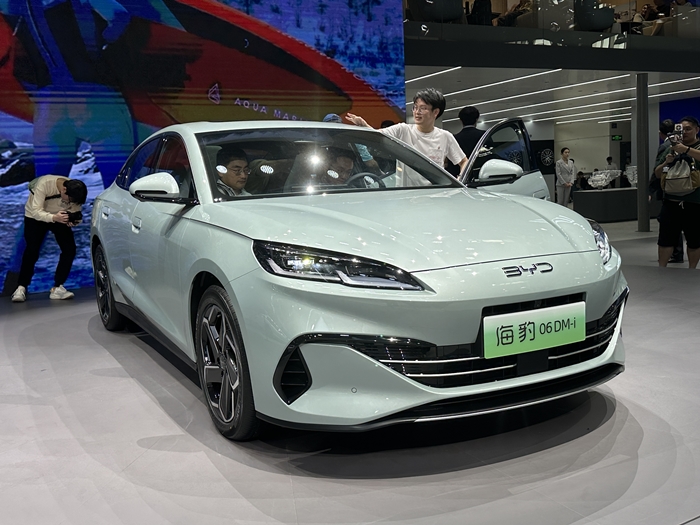BYD has literally outdistanced Tesla. — The Chinese auto giant, already a world leader in terms of combined EV and hybrid sales, has unveiled the sleek and sporty Seal 06 and its formal looking sibling, Qin L sedan.
Both of them can go 1305 miles (2100 km) on a full tank and full charge. It means you can drive from Berlin to Paris and back without the need to refuel or recharge.
In terms of distance in Central Asia, you can drive non-stop from Ashgabat to Almaty.
Bloomberg says it is equivalent to about 81 miles per gallon, more than three times the US fuel-economy average for model-year-2022 cars. It’s also about 500 more miles of range than a hybrid 2023 Lexus ES gets, which last year topped Kelley Blue Book’s list of longest-range hybrids. — 81 miles per gallon converts to nearly 34 kilometers per liter.
Business Insider says that a leap this big in hybrid technology would boost an already fervent interest in these cars, with their impressive fuel economies, lower up-front costs, and mitigated range anxiety. The models are wildly popular with both automakers and consumers as a bridge between traditional internal-combustion engines and fully electric models, especially as electric-vehicle sales plateau in many markets.
In BYD’s case, hybrids make up the majority of its models sold, Reuters reports
Toyota, a relative latecomer to EVs with a plethora of hybrid options, has seen its strategy vindicated by this softening of the market. Ford said in April that it would expand its hybrid offerings as the segment helped cushion EV losses. GM also plans to bring more hybrid models to North America in response to changing demand.
Jill Shen, writing for TechNode, says that the launch comes after figures from the China Passenger Car Association (CPCA) show that new energy vehicles (NEVs), most of which are battery electric vehicles (BEVs) and plug-in hybrids, represented more than half of China’s personal vehicle market in the first half of April.
The surpassing of the 50% mark in vehicle registrations in China came for the first time in the week of May 13-19 in a historic moment. The milestone means that NEVs are now mainstream in the country, BYD Chairman Wang Chuanfu claimed on Tuesday, citing official figures.
BYD said its fifth-gen dual-mode (DM) hybrid technology features an integrated system that covers all aspects of thermal and energy management, comprising cooling modules for front-end body parts, batteries, and in-car infotainment software, Jill Shen writes.
The company said it has also managed to reduce the excessive energy consumed in extreme weather conditions and achieved fuel consumption of 2.9L/100 km with an empty battery on the new platform.
The starting price is RMB 99,800 ($13,772).
Steve Hanley, in an article at CleanTechnica, writes that BYD says owners of cars with the new plug-in hybrid technology can save up to 9,682 yuan ($1,336) a year in fuel costs compared to driving a traditional gasoline powered car. By lightning-like calculation, that means the Qin L or Seal 06 could have a net cost of zero – as in nada – if you buy it and keep it for 10 years.
* * *
What is a plug-in hybrid EV (PHEV)?
Plug-in hybrid electric vehicles (PHEVs) use batteries to power an electric motor, as well as another fuel, such as gasoline or diesel, to power an internal combustion engine or other propulsion source. PHEVs can charge their batteries through charging equipment and regenerative braking.
PHEVs have a larger battery than regular hybrids have, so they can be driven farther and more often on electric power. As with regular hybrids, regenerative braking can extend the battery’s range, and the gasoline-powered engine and electric motor switch back and forth as needed.
BYD produces its own batteries
BYD says that a huge amount of research and development has gone into the batteries utilised within BYD’s range of cars.
BYD Blade Batteries were developed to not only improve efficiency, but to offer greater levels of safety when compared to a more common ternary lithium battery.
As an example of this, BYD subjected the Blade Battery to extreme challenges, such as nail penetration and crush tests, to see how it would respond. None of these tests resulted in a negative outcome, and surface temperatures did not exceed 60 degrees centigrade.
Compared to more traditional battery options, where some reached temperatures of up to 400 degrees in similar tests, this is a clear indication of safety you can expect from a BYD car.
Benefits of BYD’s Blade Battery
Saves Space – The internal construction of the batteries are incredibly clever, utilising individual cells fitting closely together to save space. Each cell looks like a thin blade, hence the name.
Performance and Range – Offering a great blend of usable real-world performance and range, BYD’s range of cars are perfect for a variety of motorists due to the batteries used.
With total sales of 1.25 million vehicles in the first half of 2023, the BYD brand has even entered the top 10 largest car manufacturers in the world. BYD is now at number 10, just behind Suzuki, while leaving behind major car brands such as BMW and Mercedes-Benz. /// nCa, 19 June 2024
